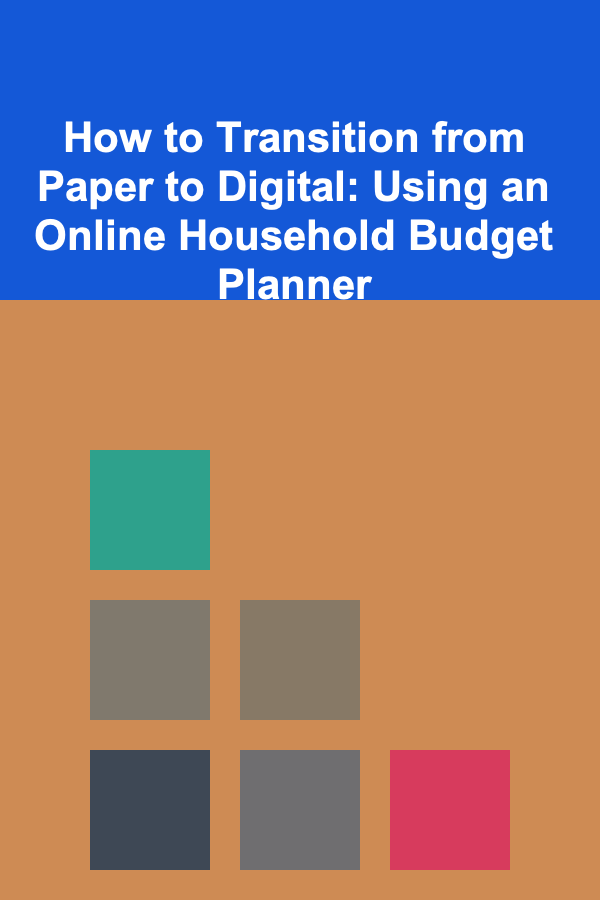
How to Transition from Paper to Digital: Using an Online Household Budget Planner
ebook include PDF & Audio bundle (Micro Guide)
$12.99$11.99
Limited Time Offer! Order within the next:

Managing household finances has traditionally involved piles of paperwork, ledgers, and manual calculations. However, as technology continues to evolve, many people are discovering the benefits of transitioning from paper-based budgeting methods to digital ones. An online household budget planner can streamline your financial management, providing convenience, accessibility, and efficiency. This comprehensive guide will walk you through the process of transitioning from a paper to a digital budgeting system, explaining the advantages of doing so and offering practical steps to get started.
Understanding the Importance of Budgeting
1. Financial Awareness
Budgeting is more than just tracking expenses; it fosters a deeper awareness of your financial situation. By understanding where your money goes each month, you can make informed decisions about spending and saving.
2. Goal Setting
A well-structured budget allows individuals and families to set clear financial goals. Whether it's saving for a vacation, paying off debt, or building an emergency fund, budgeting is the roadmap that helps achieve these objectives.
3. Preventing Overspending
Knowing your financial limits helps prevent overspending. A budget serves as a guideline, ensuring that you live within your means and avoid financial pitfalls.
4. Preparing for Emergencies
Budgeting enables you to allocate funds toward an emergency savings account. Having a financial cushion reduces stress during unforeseen circumstances, such as medical emergencies or job loss.
5. Tracking Progress
A budget allows for regular assessments of financial progress. Adjustments can be made based on performance, helping you stay on track and reach your goals more effectively.
Why Transition to Digital Budgeting?
The shift from paper to digital budgeting offers numerous advantages:
1. Accessibility
Digital budgeting tools can be accessed anywhere with an internet connection. This flexibility allows you to update your budget in real-time and check your financial status on the go.
2. Automation
Many online budget planners offer automation features, such as syncing with bank accounts and automatic transaction categorization. This eliminates the need for manual entry and reduces errors.
3. Visualization Tools
Digital budgeting platforms often include charts, graphs, and dashboards that provide visual representations of your financial data. These tools help you quickly assess your spending patterns and progress towards goals.
4. Enhanced Security
Online budget planners typically incorporate security measures, such as encryption and two-factor authentication, adding a layer of protection that physical documents may lack.
5. Integration with Other Financial Tools
Digital budgeting tools can integrate with various financial applications, including investment trackers, expense management systems, and savings platforms, creating a comprehensive financial management ecosystem.
Steps to Transition from Paper to Digital Budgeting
Transitioning to a digital budgeting system involves several practical steps. Below, we'll outline a structured approach to facilitate this change.
Step 1: Assess Your Current Paper Budgeting System
Before making the transition, take time to evaluate your existing paper budgeting system. Consider the following questions:
- What methods are you currently using to track income and expenses?
- Are there any specific challenges or frustrations you encounter with paper budgeting?
- What goals do you aim to achieve with a digital system?
By reflecting on these aspects, you can identify what you want to improve and how digital tools can address those needs.
Step 2: Research Available Online Budget Planners
There are various online budgeting tools available, each with its unique features and functionalities. Some popular options include:
- Mint: A free budgeting tool that provides automatic expense tracking by linking to bank accounts.
- YNAB (You Need A Budget): A paid budgeting software focusing on proactive budgeting and goal-setting.
- EveryDollar: A straightforward budgeting app that allows you to create custom budgets based on your income and expenses.
- PocketGuard: Offers insights into how much disposable income you have after accounting for bills, goals, and necessities.
Take the time to research and compare different platforms. Look for user reviews, functionality, ease of use, and pricing plans to determine which one aligns best with your needs.
Step 3: Choose the Right Tool for You
Once you've researched available options, select the budgeting tool that suits your preferences. Consider factors such as:
- User Interface: Is the platform easy to navigate?
- Features: Does it offer the specific functionalities you require (e.g., goal tracking, reporting, bill reminders)?
- Accessibility: Can you access it on multiple devices (desktop, mobile)?
- Cost: Is it within your budget, considering any subscription fees?
Step 4: Set Up Your Digital Budgeting Account
After selecting the right online budgeting tool, follow the registration process to create your account. Generally, this involves:
- Providing basic information (name, email, password)
- Verifying your email address
- Setting up security features, such as two-factor authentication
Step 5: Transfer Data from Paper to Digital
Begin the process of transferring your financial data from your paper system to the digital platform. This step involves entering your current income, expenses, and financial goals into the online budget planner.
Tips for Data Entry:
- Categorize Expenses: Organize your expenses into categories that mirror your paper system (e.g., housing, utilities, groceries).
- Use Historical Data: If possible, input historical data, such as the previous three months of spending, to provide context for your new budget.
- Set Up Recurring Transactions: Many digital tools allow you to automate regular transactions, such as monthly rent or utility payments. Take advantage of this feature for efficiency.
Step 6: Customize Your Budget
Once your data is transferred, customize your digital budget according to your financial goals and preferences. Establish spending limits for various categories and set aside funds for savings.
Key Customizations to Consider:
- Adjust Categories: Modify the default categories to suit your unique financial situation.
- Set Savings Goals: Create specific goals for short-term and long-term savings, such as an emergency fund or a vacation fund.
- Implement Alerts: Use notification features to remind you of upcoming bills or when you exceed spending limits.
Step 7: Monitor and Adjust Regularly
With your digital budget established, it's crucial to monitor your spending regularly. Check your budget weekly or monthly to assess your progress and make necessary adjustments.
Key Monitoring Techniques:
- Review Spending Patterns: Analyze your spending habits to identify any discrepancies or areas for improvement.
- Track Progress Towards Goals: Evaluate how close you are to reaching your savings goals and adjust your budget accordingly.
- Make Adjustments: Don't hesitate to modify your budget if you find certain categories consistently over or underspent.
Step 8: Leverage Additional Features
Finally, explore additional features offered by your chosen budgeting tool. Many platforms provide valuable resources that can enhance your financial management experience.
Examples of Additional Features:
- Reports and Analytics: Dive into reports that give insights into your spending trends and overall financial health.
- Financial Education Resources: Take advantage of articles, videos, and tutorials offered by budgeting tools to boost your financial literacy.
- Integration with Investments: If available, connect your budgeting tool with investment accounts to monitor net worth and growth.
Overcoming Challenges During the Transition
While transitioning to a digital budgeting system can offer numerous benefits, challenges may arise. Here are common hurdles and strategies to overcome them:
1. Technological Resistance
Some individuals may feel apprehensive about using digital tools, particularly if they are accustomed to traditional methods. To combat this resistance:
- Start with simple budgeting apps that require minimal setup.
- Utilize tutorial resources provided by the budgeting tool to familiarize yourself with its functions.
2. Data Entry Fatigue
Transferring data from paper to digital can be time-consuming. Consider breaking the task into smaller segments to avoid feeling overwhelmed.
Strategy:
- Dedicate time each day to input a portion of your data until the entire system is set up.
3. Loss of Control
Shifting from manual tracking to automated processes may leave some individuals feeling less in control. To maintain a sense of oversight:
- Schedule regular check-ins to review your budget and spending.
- Customize alerts and notifications to keep you informed of important financial updates.
4. Privacy Concerns
Many individuals worry about sharing their financial data online. Ensure that the budgeting tool you choose uses robust security measures, such as encryption and secure connections.
Best Practices:
- Research the provider's privacy policy and security protocols.
- Enable two-factor authentication for added security.
The Long-Term Benefits of Digital Budgeting
Transitioning from paper to digital budgeting not only enhances convenience but also contributes to long-term financial stability. Here are some key benefits you can expect as you embrace digital financial management:
1. Greater Insight into Financial Habits
Digital budgeting tools provide detailed insights into your spending habits. By analyzing reports and visualizations, you gain a clearer understanding of your financial behavior, enabling informed decision-making.
2. Improved Financial Organization
With everything stored digitally, accessing your financial records becomes easier. No more rummaging through stacks of papers---find what you need with a few clicks.
3. Better Goal Achievement
As you regularly monitor your budget and savings goals, you're more likely to stick to your plans. The accountability provided by digital tools encourages sustained progress toward your financial aspirations.
4. Enhanced Financial Literacy
Using an online budget planner often exposes users to financial concepts and strategies. As you engage with the tool, you increase your financial literacy, fostering growth in your personal finance skills.
5. Stress Reduction
Ultimately, a well-organized digital budgeting system reduces stress associated with financial management. Knowing that your finances are tracked and optimized allows you to focus on other aspects of life without the burden of uncertainty.
Conclusion
Transitioning from a paper-based budgeting system to a digital one can significantly enhance your financial management experience. By embracing technology, you gain increased accessibility, automation, and insight into your spending habits---all of which contribute to improved financial health.
Follow the outlined steps to ensure a smooth transition, and remain committed to monitoring and adjusting your budget regularly. With dedication and the right tools, you can achieve a balanced financial lifestyle that aligns with your goals and values. Start your journey today by exploring the world of online household budget planners and take control of your financial future!
Reading More From Our Other Websites
- [Organization Tip 101] How to Secure Your Home with Quality Locks and Deadbolts
- [Home Cleaning 101] How to Clean a Microwave with Lemon: A Natural Cleaning Hack
- [Personal Care Tips 101] How to Use Toothpaste for Effective Morning and Nighttime Oral Care
- [Biking 101] Top 5 Bike Derailleurs for Performance and Durability
- [Organization Tip 101] How to Use Color-Coding for Better Digital Organization
- [Home Party Planning 101] How to Personalize Themed Birthday Party Ideas to Make Your Home Party Unforgettable
- [Home Staging 101] How to Stage Your Home for a Modern Look
- [Personal Finance Management 101] How to Teach Your Kids About Money Management
- [Home Staging 101] How to Use Neutral Rugs and Carpets to Anchor Your Staged Rooms
- [Home Budget 101] How to Budget for Home Entertainment (Streaming, Games, etc.)

How to Create a Bright and Cheerful Kitchen with Lighting
Read More
How to Maximize Savings: Taking Advantage of Educational Discounts
Read More
How to Use Data to Drive Your Charitable Decisions
Read More
How to Use Vintage Holiday Decor to Create a Nostalgic Atmosphere
Read More
Mastering Graphic Design: Techniques and Trends for the Modern Graphic Designer
Read More
How to Decorate Cakes Like a Pro
Read MoreOther Products

How to Create a Bright and Cheerful Kitchen with Lighting
Read More
How to Maximize Savings: Taking Advantage of Educational Discounts
Read More
How to Use Data to Drive Your Charitable Decisions
Read More
How to Use Vintage Holiday Decor to Create a Nostalgic Atmosphere
Read More
Mastering Graphic Design: Techniques and Trends for the Modern Graphic Designer
Read More